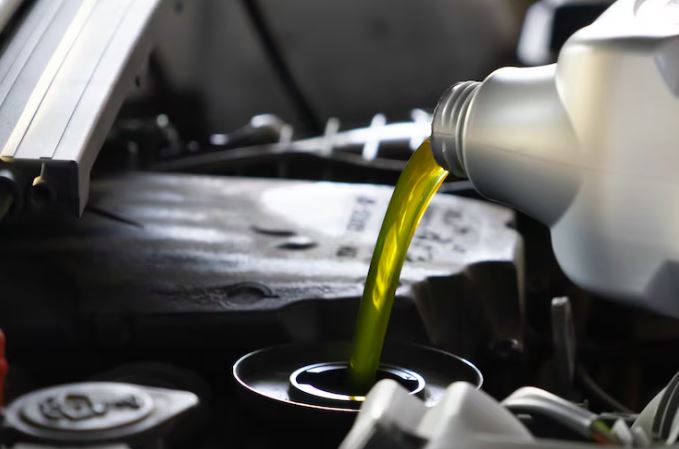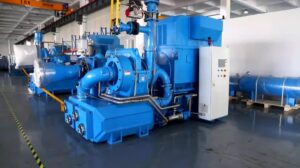Group 3 Base Oil: Reliable Group 3 Base Oil Suppliers
Group 3 Base Oil
Group 3 base oils are highly refined mineral oils that offer near-synthetic performance levels due to their extensive refining processes. These oils are characterized by their high viscosity index, excellent oxidation stability, and low volatility. The refining process involves severe hydrocracking and hydroisomerization, which significantly reduces the presence of impurities such as sulfur and aromatics. As a result, Group 3 base oils have a high proportion of saturated hydrocarbons, providing superior performance in terms of thermal stability and cleanliness. They are commonly used in high-performance automotive lubricants, industrial oils, and other demanding applications where longevity and reliability are crucial. While they are more cost-effective than fully synthetic oils (Group 4), they still deliver outstanding performance, making them a popular choice for many industries.
Advantages of Using Group 3 Base Oils
- Performance: High viscosity index ensures consistent performance across temperature ranges.
- Longevity: Enhanced oxidation stability extends the life of lubricants.
- Fuel Efficiency: Reduced friction improves fuel efficiency in engines.
- Purity: Low impurity levels minimize deposits and sludge formation.
- Versatility: Suitable for a wide range of applications including automotive and industrial uses.
- Cost-Effective: Offers a cost-effective alternative to synthetic oils with similar performance benefits.
Applications of Group 3 Base Oils
In industrial settings, Group 3 base oils are used in hydraulic fluids, compressor oils, and turbine oils, where their thermal stability and long service life contribute to improved equipment reliability and efficiency. They are also employed in the manufacturing of metalworking fluids and greases, providing enhanced lubrication and protection in demanding processes. Additionally, Group 3 base oils are used in the formulation of synthetic lubricants, which offer superior performance in extreme conditions. Their versatility and high-performance properties make them a valuable component in various lubrication solutions across different industries.
What are Group 3 Base Oil Production Process
The production of base oils involves several key steps, starting with the extraction of crude oil. The crude oil is first heated and distilled in a fractionating column, where it is separated into various fractions based on boiling points. The heavier fractions, which contain the base oil feedstock, are then subjected to further refining processes. One of the primary refining techniques is solvent extraction, which removes unwanted aromatic compounds and improves the viscosity index of the oil.
This is followed by hydrocracking or catalytic dewaxing, where the oil is treated with hydrogen to remove impurities and enhance its stability and performance characteristics. The final step is hydrotreating, which further purifies the oil and improves its color and oxidation stability. The resulting base oils are then blended with various additives to produce finished lubricants that meet specific performance requirements. The entire production process is closely monitored to ensure the quality and consistency of the base oils.
- Extraction: Crude oil is extracted from the ground.
- Distillation: Crude oil is heated and separated into different fractions.
- Hydrotreating: Removes sulfur and other impurities.
- Hydrocracking: Breaks down large molecules into smaller ones.
- Isomerization: Converts molecules into isomers for better performance.
- Blending: Final base oil is blended with additives to enhance properties.
The Basic Properties of Base Oils
The flash point is the temperature at which the oil vapors can ignite, indicating the oil’s safety in high-temperature environments. Additionally, base oils should have good oxidation stability to resist degradation over time and thermal stability to perform well under high temperatures. These properties are critical for ensuring the reliability and efficiency of lubricants in various applications.
Group 3 Base Oil Specifications
The pour point is typically very low, allowing the oil to remain fluid in cold temperatures. The flash point is high, indicating good safety in high-temperature environments. Oxidation stability is another critical specification, as it determines the oil’s resistance to degradation over time. Additionally, Group 3 base oils have low volatility, reducing oil consumption and emissions. These specifications make Group 3 base oils suitable for a wide range of high-performance applications, including automotive, industrial, and power generation.
What are the Hydrogenation Process of Base Oils
The hydrogenation process is highly efficient and can be precisely controlled to produce base oils with specific properties tailored to different requirements. This advanced refining technique is essential for producing Group 3 base oils, which are known for their superior performance characteristics compared to conventional base oils.
What Are the Different Base Oil Groups?
Group 4 base oils are synthetic oils, specifically polyalphaolefins (PAOs), which are engineered for superior performance in extreme conditions. Group 5 base oils include all other types of synthetic and natural oils not covered by Groups 1-4, such as esters and silicones, which are used in specialized applications. Each group of base oils has unique properties that make them suitable for different types of lubricants and applications.
Are the API Group Classifications Progressively Better?
The API group classifications for base oils, ranging from Group 1 to Group 5, are not necessarily progressively better but rather different in terms of refining processes and performance characteristics. Group 1 base oils, being the least refined, have higher levels of sulfur and aromatics and are typically used in applications where cost is a major consideration.
Group 2 base oils offer better performance due to hydroprocessing, which reduces impurities and improves stability. Group 3 base oils, which undergo more extensive hydroprocessing, provide even higher performance with a higher viscosity index and better oxidation stability. Group 4 base oils, being synthetic polyalphaolefins (PAOs), offer the best performance in extreme conditions due to their engineered molecular structure.
Group 5 base oils include a wide range of synthetic and natural oils with specialized properties for specific applications. Therefore, the “better” classification depends on the specific performance requirements and application rather than a simple progression from Group 1 to Group 5.
Are Group 3 Base Oils "Synthetic?"

This includes a high viscosity index, excellent oxidation stability, and low volatility. In many regions, including Europe, Group 3 base oils are legally classified as synthetic. However, in the United States, the term “synthetic” is more commonly associated with Group 4 base oils, which are chemically engineered from pure chemical compounds. Despite this distinction, Group 3 base oils are widely recognized for their high performance and are used in many synthetic and semi-synthetic lubricants, offering a cost-effective alternative to Group 4 synthetics for many applications.
Are Synthetic Base Oils Magic?
These characteristics make synthetic base oils ideal for high-performance and extreme-condition applications, such as in high-speed engines, high-temperature industrial machinery, and low-temperature environments. Additionally, synthetic base oils tend to have longer service life and better compatibility with modern engine technologies, reducing the need for frequent oil changes and improving overall efficiency. While not magical, the advanced technology behind synthetic base oils offers tangible benefits that enhance the performance and longevity of lubricated equipment.
Group 3 vs Group 4 Oil
in uniform molecular structures that provide even greater performance benefits, such as higher thermal stability, better low-temperature fluidity, and longer service life. While Group 3 oils offer a cost-effective alternative to PAOs and are suitable for many high-performance applications, Group 4 oils are preferred for the most demanding environments and conditions due to their unparalleled stability and performance. The choice between Group 3 and Group 4 oils depends on the specific requirements of the application and the desired balance between cost and performance.
Group 3 Base Oil Suppliers: By Rumanza
“Rumanza” is a notable of Group 3 base oils supplier , recognized for its commitment to quality and innovation. As a key player in the lubricant industry, Rumanza produces high-quality Group 3 base oils that meet stringent performance standards. Their products are characterized by a high viscosity index, excellent oxidation stability, and low volatility, making them suitable for a wide range of demanding applications. Rumanza’s state-of-the-art production facilities utilize advanced hydroprocessing and hydrocracking technologies to ensure the purity and consistency of their base oils.
The company also invests in extensive research and development to continuously enhance the performance characteristics of their products, catering to the evolving needs of industries such as automotive, industrial machinery, and power generation. By offering technical support and customized solutions, Rumanza helps its customers optimize their lubrication processes and achieve greater efficiency and reliability in their operations. Their reputation for quality and innovation makes Rumanza a trusted supplier of Group 3 base oils in the global market.
Final Thoughts
Group 3 base oils, continuously investing in research and development to meet the evolving needs of their customers. Understanding the different base oil groups and the advantages of using Group 3 base oils can help industries make informed decisions about their lubrication needs, leading to improved efficiency, reduced downtime, and lower operational costs. Whether used in high-performance engine oils, industrial lubricants, or synthetic formulations, Group 3 base oils provide a reliable and cost-effective solution for modern lubrication challenges.
FAQs

Calcium Sulphonate Grease UAE | High-Temperature Grease
Calcium Sulphonate Grease UAE | High-Temperature Grease Discover More Introduction: The Unforgiving Demands of UAE Industry The United Arab Emirates stands as a global titan of industry and infrastructure. From the sprawling metallurgical plants in Mussafah and the massive port operations of Jebel Ali to the relentless pace of construction shaping Dubai’s skyline and the vast logistics hubs of Al Ain, the machinery that powers this nation operates under extreme duress. Soaring ambient temperatures that regularly exceed 45°C, pervasive dust

What is Rubber Process Oil? | Guide to Applications, Benefits, and Selection
What is Rubber Process Oil? | Guide to Applications, Benefits, and Selection Discover More In the sophisticated ecosystem of rubber manufacturing, raw polymers are the canvas, but rubber process oil is the essential medium that brings the masterpiece to life. It is the critical component that transforms rigid, unworkable raw materials into the versatile, durable, and high-performance rubber products that define modern industry and daily convenience. For specialists dedicated to chemical innovation and precision, such as the team at Rumanza Lubricants, the science

Which UAE Lubricants manufacturers is Best for High-Mileage Engines?
Which UAE Lubricants manufacturers is Best for High-Mileage Engines? Discover More The sprawling deserts and bustling metropolises of the United Arab Emirates present a uniquely demanding environment for vehicles, pushing engine lubrication technology to its absolute limits. From the scorching summer heat that can cause conventional oils to thin out and lose protective properties, to the endless stop-start traffic of cities like Dubai and Abu Dhabi that promotes sludge and acidic buildup, our cars endure a severe service regimen unlike

What Vehicles Use Kerasene? A Comprehensive Guide
What Vehicles Use Kerasene? A Comprehensive Guide to Fueling Beyond Gasoline Discover More When we think of vehicle fuel, gasoline and diesel immediately come to mind. They are the lifeblood of our daily commutes, the power behind the trucks that deliver our goods, and the standard by which we measure automotive progress. But venture beyond the everyday, into the realms of high-altitude aviation, rugged agricultural machinery, and groundbreaking space exploration, and you’ll discover a different, equally vital fuel that operates

How To Chose Antioxidant Additives in UAE | Industrial Grade Chemicals?
How To Chose Antioxidant Additives in UAE | Industrial Grade Chemicals? Discover More In the heart of a rapidly industrializing region, the United Arab Emirates stands as a beacon of manufacturing, logistics, and heavy industry. From the sprawling automotive workshops of Dubai to the massive petrochemical complexes in Ruwais, the performance and longevity of machinery are paramount. At the core of this operational excellence lies a critical, yet often overlooked, component: industrial lubricants and fluids. These lifeblood substances are constantly

Viscosity Index Improvers UAE – Improve Lubricant Performance
Viscosity Index Improvers UAE – Improve Lubricant Performance Discover More In the heart of the United Arab Emirates, where ambition is matched only by the scale of its infrastructure, the machinery that builds and powers the nation faces a relentless adversary: the climate. The combination of extreme heat, temperature volatility, abrasive dust, and intense UV radiation creates a perfect storm of conditions that relentlessly attack the lifeblood of all mechanical systems—the lubricant. For maintenance managers, plant operators, and fleet owners,

Compressor Oils UAE | Lubricants for Air Compressors
Compressor Oils UAE | Lubricants for Air Compressors Discover More In the relentless engine of the UAE’s economy, where ambition is matched only by the scale of its construction and industry, air compressors are the indispensable workhorses. They are the silent force driving the pneumatic tools that build our skylines, the automated machinery in our factories, the climate control systems in our buildings, and even the processes in oil and gas refineries. Yet, within these critical machines, a component often

How to Chose Best Diesel Engine Oil in UAE for Your Vehicle | Get Quote
Guide to Choosing the Best Diesel Engine Oil in UAE For Your Vehicle Discover More In the United Arab Emirates, the relationship between a driver and their vehicle is forged in fire. The unrelenting sun, the searing asphalt, and the ever-present fine sand create an operating environment that is among the most punishing on Earth. For the diesel engines that power the UAE’s growth—from the rugged Land Cruisers conquering dunes to the Ford F-150s on city streets and the fleets

What Are the Latest Trends in Sustainable Industrial Oils for UAE Manufacturers?
What Are the Latest Trends in Sustainable Industrial Oils for UAE Manufacturers? Discover More Industrial oils form the lifeline of heavy industries, enabling machines, turbines, compressors, and production lines to function seamlessly. They reduce friction, cool equipment, prevent wear, and ensure uninterrupted operations. In a fast-developing economy like the UAE—where energy, petrochemicals, construction, and manufacturing drive growth—industrial oils are indispensable. But today, the conversation around industrial oils is no longer limited to performance. Global concerns about climate change, carbon emissions,